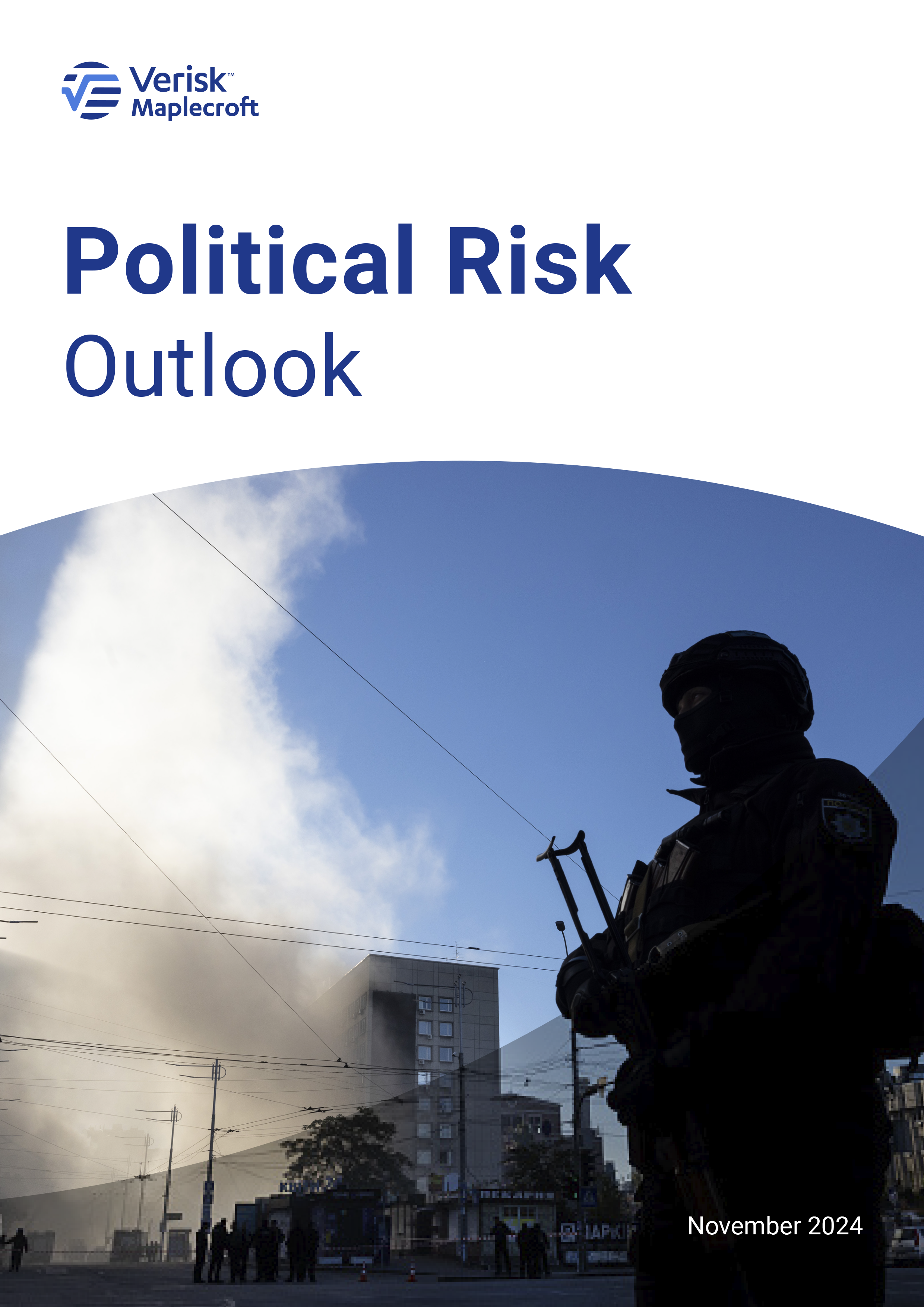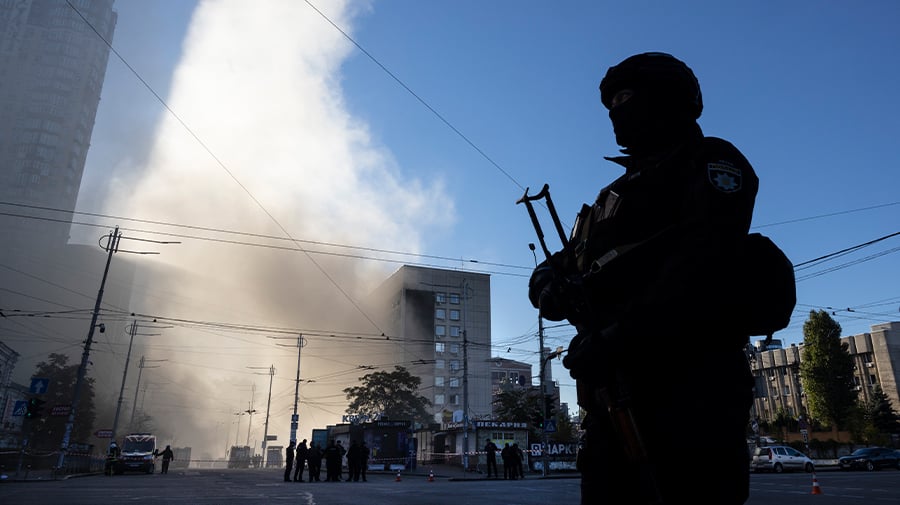Conflict-affected areas across the world have grown 65% since 2021 to encompass 4.6% of the entire global landmass, up from 2.8% three years ago. That is equivalent to 6.15 million km2, nearly double the size of India, that is now afflicted by fighting between or within states, according to our Conflict Intensity Index (CII).
From the widespread human cost and increased migration to the widening of geopolitical fault lines, the damaging economic impacts and threats to international trade and supply chains, the consequences of the upsurge in conflict are globally significant. The spread of violence is mirrored by rising casualty rates, with conflict deaths on course to breach 200,000 by the end of the year, up 29% on 2021.
The Middle East and Ukraine remain the most intense theatres of war, and both have the capacity to escalate. The spread of conflict in these geographies is well documented, in part because of their geopolitical significance. However, the Conflict Intensity Index, which measures the severity of armed conflict at subnational levels across 198 countries, also provides valuable insights into countries and regions that are less well reported on.
In total, 27 countries, including the emerging markets of Ecuador, Colombia, India, Indonesia and Thailand, have experienced a significant increase in risk since 2021. However, in terms of areas affected by conflict, sub-Saharan Africa has seen a greater expansion than any other region.
Africa’s ‘conflict corridor’ doubles in size
Africa’s ‘conflict corridor,’ which now spans 4,000 miles from Mali in the west to Somalia in the east, has doubled in size since 2021. As a result, areas affected by conflict in 14 countries across the Sahel and East Africa now equate to around 10% of sub-Saharan Africa’s overall land mass or 2.5 million km2, more than 10 times the size of the UK.
The escalation is most pronounced in Burkina Faso, where 86% of the country is now embroiled in conflict between state forces and militants. Over the same period, conflict areas in the civil wars in Sudan and Ethiopia have expanded by more than 20% and 30% respectively, while armed violence in Nigeria now affects 44% of its territory.
The geographical spread of conflict is not the only issue though. According to the CII, conflict fatalities across the conflict corridor this year are also on course to increase by over 50% compared to 2021.
Beyond Africa, several other lesser-known conflicts are also contributing to this upswing. The civil war in Myanmar, which has been raging since the 2021 coup d’état, has seen the South-East Asian state fall from the 19th to the 2nd worst performing country in the latest edition of the CII. Haiti and Ecuador have similarly chalked up statistically ‘exceptional’ deteriorations on the index amid surging gang violence, which has escalated from criminality to the declaration of internal conflicts.
Conflicts in Middle East and Ukraine are volatile swing factors
The Middle East is unsurprisingly one of the key drivers in the upward global conflict trend. Israel, the Palestinian Territories, Lebanon, Syria, and Yemen are all now ranked among the 10 highest risk jurisdictions globally on the CII.
Following the 7 October 2023 terrorist attack on Israel by Hamas, and the subsequent retaliation by the Netanyahu government against Iran’s so-called ‘Axis of Resistance’, the region remains on a knife-edge. Rapidly increasing tensions between Iran and Israel point to the potential for conflict in the Middle East to escalate even further. Israel’s focus to-date has been on degrading Iranian proxy groups in Gaza, Lebanon, Syria and Yemen. But the volatile situation could yet deteriorate to the point where Iran itself and even Gulf states become new centres of conflict in the months ahead.
Russia’s full-scale invasion of Ukraine similarly represents another important driver of the global uptick in conflict, with the proportion of Ukrainian territory affected by the fighting rising from under 8.6% to 70.5% since February 2022. Perhaps more surprisingly, the amount of Russian territory affected by conflict has increased more than 10-fold over the same period – albeit from a very low base – amid cross-border shelling, Ukrainian drone and missile attacks, covert raids and Kyiv’s Kursk offensive. Donald Trump’s re-election to the US presidency increases the prospect of a ceasefire in Ukraine, but any peace will likely be fragile and reversible.
Intensifying global conflict has a myriad of consequences
The human toll of conflict is alarming. Global conflict fatalities could breach 200,000 by the end of the year, up nearly a third since 2021, according to our assessment of Armed Conflict Location and Events Data (ACLED). The UN also estimated that the number of people displaced by conflict, violence or persecution exceeded over 120 million by the end of April 2024.
From an economic perspective, the cost of conflict can also be devastating. The latest UN estimate is that the war in Ukraine has caused USD152 billion in direct damage and the cost of reconstruction and recovery will reach nearly USD500 billion. The cost of rebuilding Gaza is estimated at over USD80 billion.
In addition, the direct and indirect threats to businesses need to be closely monitored. Data from our Asset Risk Exposure Analytics (AREA) – which measures the exposure of over 4 million assets of publicly listed companies to political, human rights, climate and environmental risks – shows that corporate exposure to conflict is currently limited. Only 3.68% of the assets of the highest risk sector, oil & gas, are exposed to conflict, but this could change rapidly if conflict in the Middle East escalates.
Global supply chains, on the other hand, are more exposed to war-related impacts. Most notably, the disruption to Red Sea maritime trade caused by the Iranian-backed Houthi rebels in Yemen attacking Western shipping shows no sign of ending and has led to increased shipping and insurance costs. The fallout from Russia’s invasion of Ukraine likewise roiled global supply chains, from energy to fertiliser through to agri-commodities.
Where might the next bout of armed conflict break out?
The rise in global conflict puts geopolitical tensions firmly in the global spotlight. Outside of the Middle East, the Indo-Pacific is one region to watch due to its multiple potential geopolitical flashpoints. Our Interstate Tensions Model, which assesses the risk of bilateral tensions spilling over into a confrontation that entails the threat, display, or use of force, identifies China-Taiwan, North Korea-South Korea and China- Philippines as very high risk pairings.
There is little sign that the recent upsurge in armed conflict – and all the tragedy and challenges that go with it – will dissipate in 2025. Indeed, the situation may get worse before it gets better.






